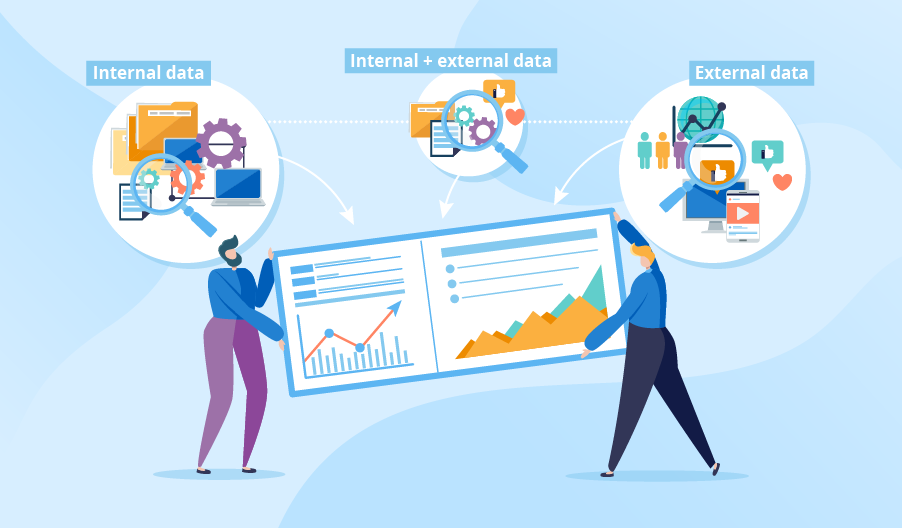In the business world, data and analytics are rapidly becoming more important than ever. That's because they provide a way to understand your customers better, improve operations, improve sales efficiency, and so much more. However, if you're not already using these tools in some capacity within your organization or department then it might be time for a change!
As leaders in the field of data, analytics and CIOs are always looking for new ways to improve their organizations' performance. Many of these improvements come from implementing new technologies or processes into an organization's existing structure. According to the Data Driven Enterprises of 2025 by McKinsey, The corporate balance sheet and intelligent processes will likely be as prevalent by 2025, and the majority of employees will use data to optimize almost every element of their work. These 3 steps will surely help your business become a data and analytics enterprise:
Step 1. Modernize your data infrastructure
Data is the new oil, currency and lifeblood of business. Data is what drives innovation, growth and competitiveness in any industry. The most successful companies have a strong understanding of how to use data effectively for their businesses, as well as how to use it as an input into their decision-making processes. They understand that good decisions will only happen if they have access to high quality information from all sources—internal and external—and can act on that information quickly with confidence.
To achieve this level of success you need a modernized infrastructure that supports all types of applications: reporting tools; analytics tools; development environments (including programming languages); process management solutions including deployment automation solutions such as continuous integration (CI); serverless architectures using containers/microservices etc., so you can easily scale up or down depending on demand without any impact on performance metrics such as latency or throughput times during peak hours per day when doing queries against databases like Oracle which may lead one into thinking something might be wrong with their system but there's nothing wrong here -
1. Balance the three Vs of Volume, Velocity, and Variety
As you're planning your data and analytics driven enterprise, it's important to balance the three Vs of volume, velocity and variety. In other words:
-
Volume - The amount of information that needs to be handled.
-
Velocity - How fast new data gets processed (how fast we can get from one stage in our pipeline to another).
-
Variety - The different types of data we have at our disposal (e.g., transactional vs operational).
2. Gather all data sources in one place and Start a Pilot
Gathering all data sources in one place is of utmost importance. By having a single source of truth, you can easily access and analyze your data. Having this single system of record will make it easier for everyone to understand what's going on with the business. This also helps provide transparency across teams, which is critical if they're going to be able to make informed decisions based on facts rather than hunches or rumors (which often lead them astray).
It's also important that any organization has scalable, secure and flexible systems so that they can grow as quickly as needed without compromising on accuracy or security—and here again Google Cloud Platform shines brightly through its ability to scale both horizontally (up) and vertically (down).
A pilot is a small-scale project that you can use to test your business model. It’s a way for you to validate your assumptions about what will work and what won’t in order to optimize the process of moving forward with an idea or product. It allows you to see if there are any problems with the way things are done at your organization before investing too much time and money into them. By testing out possible solutions, it lets us learn more about our customers' needs so that we can create products they actually want!
A pilot also helps us figure out how well our new tools fit into the existing system—we might find out that they don't work as well together as we thought they would (or vice versa). If this happens during a trial run, then there's no need for anyone else (including ourselves) involved!
3. Analyze data in real time
Real-time analytics is essential for making business decisions. Real-time analytics can be used to monitor and predict, which is useful in any industry where data is available. Real-time analytics can also be used to make decisions, such as those made by an employee who wants a better work environment or one that will help them achieve their personal goals. In addition, real-time analytics helps improve business processes such as how long it takes employees in your company's call center department from answering an incoming call until they're able to transfer the customer over into another department or agent who can take care of their needs quicker than usual because there was no wait time (and thus less frustration).
4. Handle structured, semi-structured, and unstructured data
You should start by understanding what is structured, semi-structured, and unstructured data.
Structured data is organized in a predefined way. They have a specific format, such as dates and numbers. Semi-structured is more flexible than structured data but still has some structure to it. Unstructured refers to any type of data that hasn't been organized in any manner whatsoever — everything from emails to handwritten notes on napkins can fall into this category!
Step 2. Build a holistic view of the business
The second step to becoming a data and analytics driven enterprise is to build a holistic view of your business. The first step was about creating an internal culture that embraces data and analytics, but this second step is about creating an external one as well. This means gathering all data sources in one place so you can analyze them in real time, not just once every couple weeks or months like most organizations do today. It also means balancing the three Vs—volume (the amount), velocity (the speed at which things move), and variety (the number of options).
Convert insights into actionable solutions across the business
Move from building a model to operationalizing the insights generated from it. For instance, if you have generated insights that say “users who visit pages with more than 10 pictures are likely to be interested in purchasing our product”, then this insight can be used by your sales team to target their campaigns more effectively. Alternatively if you have found out that users who have visited certain pages are likely to purchase a particular product but only after reading about two other products first (and these were also recommended by others), then this information could help inform how well-branded content is being shared across your company's social media platforms. In either case - regardless of whether or not any actionable steps are taken as a result - having data and analytics at hand means that decisions are being made based on real world evidence rather than hunches or intuition alone! Use a structured approach to become data driven:
-
What problem are you trying to solve?
-
What data do you need?
-
How will you get the data?
-
How will you analyze the data?
-
How will you operationalize the insights?
Start somewhere. Just because it's easier to start with one problem doesn't mean that's where your journey will end up taking you. You need a plan and then keep going until it works for your business — don't stop just because something feels like a challenge (or is really hard). Make sure that whatever path leads toward success also includes measuring progress along the way so that there are clear checkpoints along with evidence of success at every turn!
Data and analytics revolution is here to stay. If a company doesn't have a strong understanding of its customer base and their needs, it's hard to know what they want or how best to serve them. Data-driven enterprises can no longer afford not being on top of trends—they need actionable insights from their data and analytics so they can make informed decisions about where their customers are going next.
It's also important for companies who want to be successful in this new world order (and who don't want their competitors to be ahead of them) that they look beyond traditional methods like surveys or focus groups—because those aren't going away anytime soon!
Step 3. Invest in creating a culture that embraces daya and analytics
The third step to becoming a data and analytics driven enterprise is to invest in creating a culture that embraces daya and analytics. This involves:
-
How to infuse data-driven thinking in every department
-
How to convert insights into actionable solutions across the business
-
How to build a holistic view of the business
1. Infuse data-driven thinking into every department
Data-driven thinking has become a buzzword in the business world. But what does data-driven thinking really mean? It’s not just a skill, it's a mindset. Data science skills will help you to collect and analyze data, but they won't give you all the answers on how to use that information to make better decisions and improve your business.
It's not just about technology—it's about culture as well! If your organization doesn't have any formalized programs or processes around collecting, analyzing and sharing data then there is no way for them to truly be “data driven” (and if they claim otherwise then it means nothing).
Conclusion
As we’ve discussed, data and analytics are no longer just a tool to improve your business. They are now an integral part of every aspect of your company and can help you make informed decisions that will help drive growth and profitability. The key is to start building these tools today so that they can become second nature when it comes time for decision making later on down the road!



